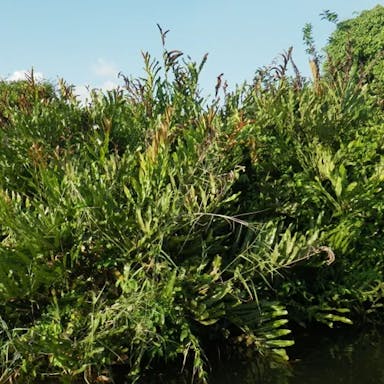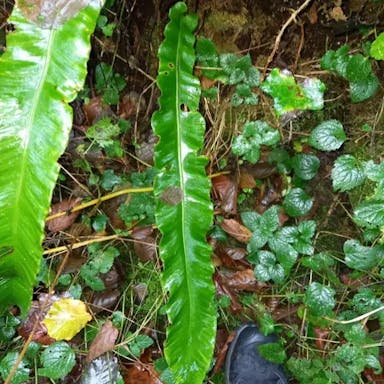Mother fern, also known as Asplenium bulbiferum, is a unique and fascinating plant in the Asplenium genus. This fern requires moist and shady environments of Australia and New Zealand. The fascination lies in its distinctive fronds, which are long and arching, reaching up to 1 meter in length. Unlike many ferns, this fern does not have flowers. The reproduction uses the bulbils that appear on the fronds. These fall and help propagate. Mother fern can grow quite large as an evergreen plant. It needs well-draining soil and some humidity. With proper care, it makes an excellent addition to gardens.
Mother fern
- Scientific name
- Asplenium bulbiferum
Basic Information
- Aspleniaceae Family Asplenium Genus Mother fern Species
- Aspleniaceae > Asplenium > Asplenium bulbiferum
- 83%
- The Completeness of This Encyclopedia
Please help us complete the encyclopedia, Terrarium is a encyclopedia service to be completed with everyone in the world. Currently, this page is 83% complete. For more information on how to contribute, please click here.
- Pteridophyta
- Height
- 60cm ~
- Flower Color
- Leaf Color
- Anthesis
- Sunlight Exposure
Full Sun Long hours of sunlight from morning to afternoon Partial Shade A location in the shade of a tree or where either the morning or afternoon is shaded Full Shade A place where there is no direct sunlight
- Partial Shade
- Hardiness Zones
This is an indicator to know to which zone each plant can winter. Knowing the zone of each plant gives you an idea of the cold temperature resistance when grown in the ground without a roof. 2: -42.7 to -40.0 3: -39.9 to -34.4 4: -34.3 to -28.9 5: -28.8 to -23.3 6: -23.2 to -17.8 7: -17.7 to -12.2 8: -12.1 to -6.7 9: -6.6 to -1.1 10: -1.0 to 4.4 11: 4.5 to 10.0
- 9
- Cold resistance
- Fair
- Heat resistance
- Fair
- Habitat of origin
- New Zealand
- Growth Rate
- Normal
What is Mother fern (Asplenium bulbiferum)?
What is Mother fern (Asplenium bulbiferum)
Flower meaning
The flower language commonly used in America for the plant called Mother fern is confidence or trust. This language is often associated with the Mother fern due to its strong and resilient nature. The Mother fern symbolizes the confidence and trust one can have in themselves and others. It represents the belief in one's abilities and the ability to overcome challenges. The Mother fern is often given as a gift to show support and encouragement to someone who may be facing difficult times or embarking on a new journey.
Calendar of Mother fern (Asplenium bulbiferum)
Calendar
Mother fern, also referred to as Asplenium bulbiferum, is a long-living fern native to the United States. This plant blooms in the spring and summer months, from April until August. The peak blooming time for Mother fern is during June. This fern's blooming duration often continues for multiple weeks, with single flowers staying open a few days. Supplying adequate sunlight, water, nutrients helps lengthen the blooming time. Keeping steady temperature and humidity can also extend the flowering duration. Mother fern is favored for gardens and landscaping owing to its decorative leaves and dainty blooms.
How to grow Mother fern (Asplenium bulbiferum)
Watering
The optimal frequency and method of watering for the Mother fern plant depends on various factors such as the season, soil humidity, and the specific needs of the plant. When it is the growing season, which typically occurs in spring and summer, the Mother fern requires regular watering to maintain soil moisture. Watering the plant once or twice a week is recommended, ensuring that the soil is evenly moist but not waterlogged. When it is the dormant season in fall and winter, less frequent watering should occur. The Mother fern requires less water during this period as it goes into a period of rest. Only water the plant when the top of the soil feels dry. Too much water during the dormant season can lead to problems with the roots. It is important to note that the specific watering needs may vary depending on the conditions and the needs of the individual plant. Checking the soil moisture regularly and adjusting the watering frequency accordingly is crucial for the health and well-being of the Mother fern.
Soil and Fertilizer
Mother fern is known scientifically as Asplenium bulbiferum. It likes well-drained fertile soil. The pH should be slightly acidic to neutral, around 6.0 to 7.0. Good drainage allows proper root growth. The soil should have organic matter to hold some moisture. Give fertilizer during spring and summer growing times. Use a balanced mix with nitrogen, phosphorus and potassium. Established plants can be fed every 4-6 weeks. Follow directions on the fertilizer package. Too much fertilizer can hurt the plant. Regular soil testing checks pH and nutrients. Make adjustments as needed to keep the best soil for Mother fern.
Sunlight and Place
Asplenium bulbiferum is a Mother Fern plant needing partial sun. It can handle cold weather but not heat. Keep between 15 and 24 Celsius. Give shade in summer to stop leaves from burning. It likes medium light levels, so it is good inside or in shade outdoors. Give 4-6 hours indirect light daily. In winter, keep it cool and water less, like when dormant naturally. Overall, the Mother fern needs medium sun and doesn't like temperature extremes.
Advanced Information of Mother fern (Asplenium bulbiferum)
Pruning
Mother fern, scientifically known as Asplenium bulbiferum, is a popular houseplant. Pruning and cutting back are necessary to maintain its health. The best time to prune is in early spring before growing season. Use clean pruning shears to cut fronds at base, close to stem. Avoid cutting main stem or damaging healthy fronds. After pruning, remove fallen leaves to prevent disease spread. Fertilize to support new growth. Water regularly and provide adequate light. Wear gloves and eyewear when pruning ferns.
Planting and Harvest
Mother fern, also known as Asplenium bulbiferum, is a popular plant for indoor gardening. The fern enjoys a consistent moist soil with proper drainage. It requires indirect light to thrive indoors. When transferring the fern to a new container, select one slightly larger than the current pot. Gently remove the roots before replanting in fresh soil mix. Water thoroughly once repotted. Insufficient care leads to decline. Avoid overwatering and underwatering. Maintaining humidity by misting foliage can be beneficial. Pruning of dead fronds promotes new growth. With attentive care, the fern adds beauty.
Propagation
Mother fern has various propagation methods. These include sowing its seeds, dividing it, cuttings, and leaf cuttings. To propagate through sowing, collect spores from fronds. Next, sow spores on moist sterile medium. Then, cover the container to maintain humidity. Also, place it somewhere warm with indirect light. Keep the medium moist. Soon, tiny ferns will emerge. For division, separate carefully the rhizomes of an established plant. Next, replant divisions in pots or ground. Ensure each division has healthy fronds and roots. Water thoroughly. Also, provide adequate shade until new growth. To propagate through cuttings, take stem cuttings from the plant's base. Remove lower leaves. Next, dip the cut end in rooting hormone. Then, plant it in well-draining potting mix. Keep soil moist and provide indirect light. Roots should develop within weeks. Leaf cuttings can also propagate. Take a healthy leaf and cut it into sections with a vein. Plant sections in moist medium. Cover with a plastic bag. Place somewhere warm with indirect light. Keep medium moist. New plants will develop. Harvesting is unnecessary for propagating Mother fern.
Pests and Diseases
Mother fern (Asplenium bulbiferum) is susceptible to several pests and diseases. One common pest is the aphid, which feeds on the plant's sap and causes stunted growth and yellowing of leaves. Aphids can be controlled by regularly inspecting the plant and removing them manually or using insecticidal soap. Another pest is the scale insect, which forms small, shells on the plant's stems and leaves. Scale insects can be controlled by pruning infested areas and applying horticultural oil. Mother fern is also susceptible to fungal diseases like leaf spot and root rot. Leaf spot is characterized by circular spots on the leaves, which can eventually cause withering and death. It can be prevented by avoiding overhead watering and good air circulation. Root rot leads to decay of the plant's roots and withering. To prevent root rot, it is important to water only when soil is dry and ensure drainage holes. In summary, mother fern is susceptible to pests aphids and scale insects, as well as fungal diseases leaf spot and root rot. Regular inspection, removal, and appropriate practices can help prevent and control these problems.
Habitat of Mother fern (Asplenium bulbiferum)
Habitat
Toxicity of Mother fern (Asplenium bulbiferum)
Health Benefits
- edible
- Inedible
- Toxic
- No toxicity
NO DATA
Toxic for dogs and cats
NO DATA
Q&A of Mother fern (Asplenium bulbiferum)
- How to care for mother fern indoors?
To nurture Asplenium bulbiferum, popularly known as mother fern at homes, it's crucial to provide it with well-draining fertile soil and a pot having drainage holes at the bottom. This fern favors indirect sunlight, so keep it at a location where it can get bright, filtered illumination. Ensure the plant is maintained in a moist environment, as it thrives in humidity. Occasional misting or keeping the pot on a tray filled with pebbles and water can assist in preserving dampness. The mother fern likes cool temperatures, ideally between 15 to 24 degree Celsius. Overwatering must be avoided, however the soil should never get completely dry. Regularly examine the upper inch of soil and irrigate when it feels parched to the touch. Lastly, nourish the fern with a balanced liquid fertilizer every thirty days during the growing season for optimal development.
- Is there a recommended way to choose Mother fern?
Mother fern, scientifically known as Asplenium bulbiferum, is a popular choice for indoor and outdoor gardens. When purchasing seeds, it is important to choose healthy and fresh ones from reputable suppliers. Seeds specifically labeled as Mother fern will ensure the desired variety. It is worth noting that Mother fern can produce plantlets called bulbils on its fronds for propagation of new plants. In summary, selecting healthy seedlings and fresh seeds labeled as Mother fern will support successful growth in your garden.
- Where can I buy mother fern?
Mother ferns, known as Asplenium bulbiferum, are available at local nurseries, garden centers, and online retailers. When buying, ensure the seller provides healthy, disease-free plants. Sellers may offer various mother fern varieties to choose from for your needs. Before purchasing, check the plant's care needs to ensure it suits your conditions.











